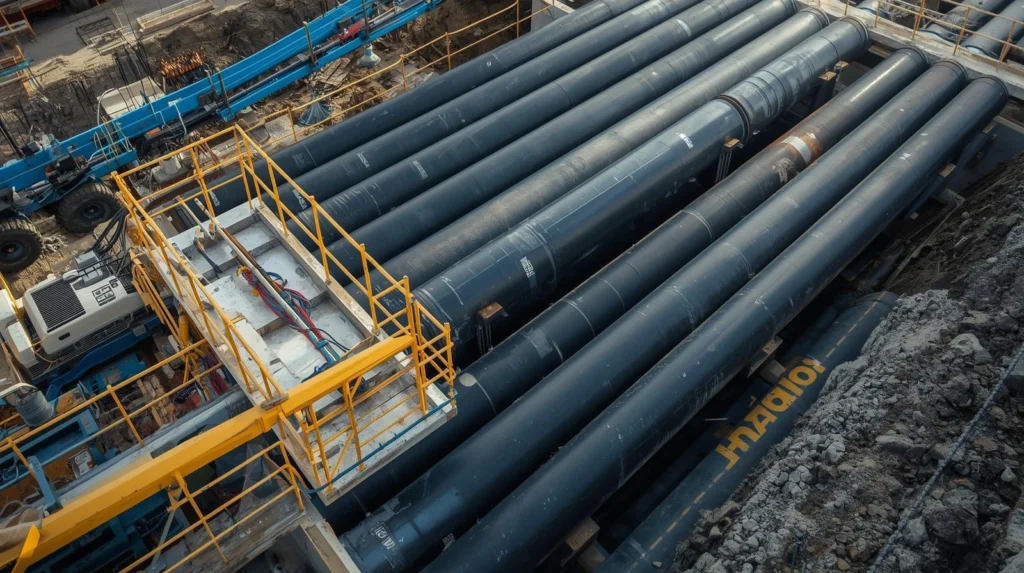The Shift to Modern Infrastructure Solutions
Are you looking for a way to boost the durability and efficiency of your construction projects? The answer might lie in the adoption of HDPE (High-Density Polyethylene) pipes. As the construction industry faces increasing pressure to modernize infrastructure while reducing costs, HDPE pipes are emerging as a revolutionary solution. These pipes are known for their resilience, ease of installation, and long-term cost savings.
In an era where sustainable practices are gaining importance, HDPE pipes are not only helping construction companies meet these demands but also shaping the future of water, gas, and sewage systems. This blog will dive into how HDPE pipes are transforming the construction industry, addressing common challenges, and providing practical insights to help you leverage this innovative material.
What Are HDPE Pipes and Why Are They Gaining Popularity?
HDPE pipes are made from high-density polyethylene, a thermoplastic polymer that is renowned for its strength, flexibility, and resistance to chemicals. These pipes are commonly used in a variety of applications, from water supply and drainage systems to gas and industrial applications. But why are HDPE pipes becoming the go-to choice in construction?
Strength and Durability
One of the most significant advantages of HDPE pipes is their impressive strength. HDPE pipes are resistant to cracking and breaking, even under extreme pressure or in challenging environmental conditions. This durability extends their lifespan, making them a cost-effective option in the long term. HDPE pipes can easily withstand a range of weather conditions, from freezing temperatures to high heat, making them ideal for both residential and industrial infrastructure.
Flexibility and Ease of Installation
Unlike traditional materials such as concrete or steel, HDPE pipes are highly flexible, which makes them easier to install, even in tight or complicated spaces. The flexibility of HDPE pipes allows them to be bent and maneuvered without compromising their integrity. As a result, they can be installed more quickly and with less labor, leading to reduced installation costs.
How HDPE Pipes Are Enhancing Construction Infrastructure
Efficient Water Supply Systems
Water supply systems are critical to modern construction, whether in urban developments or industrial projects. HDPE pipes provide a seamless solution for transporting potable water over long distances, even in harsh terrains. Their resistance to corrosion and mineral buildup means they remain effective over time, ensuring clean water reaches its destination with minimal maintenance.
Real-World Example: The use of HDPE pipes in the construction of water supply systems in remote regions of India has significantly improved water access for local communities. In addition to being more durable than traditional materials, the pipes also reduced installation costs, allowing for faster project completion.
Wastewater and Drainage Systems
For construction projects involving sewage systems, HDPE pipes are proving to be a game-changer. These pipes are highly resistant to the elements, preventing corrosion and clogging over time. Moreover, their smooth internal surface reduces friction, allowing wastewater to flow freely with minimal resistance.
Expert Insight: “HDPE pipes have revolutionized how we manage wastewater in construction. Not only do they offer better performance, but their lower installation and maintenance costs are key benefits for contractors and developers alike.” – John Smith, Civil Engineer.
Gas Distribution Networks
HDPE pipes are also making a significant impact on gas distribution networks. Traditional pipes, such as those made from steel, can corrode over time, leading to safety risks. In contrast, HDPE pipes are resistant to corrosion, making them ideal for safely transporting natural gas. They are also lighter and more flexible, simplifying installation and reducing operational disruptions during construction.
Benefits of HDPE Pipes in Sustainable Construction
Sustainability is at the forefront of modern construction. As developers and contractors look for materials that support environmentally-friendly practices, HDPE pipes offer several key benefits:
Recyclability
HDPE pipes are fully recyclable, which reduces their environmental impact. Once the pipes have reached the end of their life cycle, they can be melted down and reused to create new products, making them a sustainable choice for construction projects.
Energy Efficiency
Because HDPE pipes are lightweight, they require less energy to transport and install compared to traditional materials. Their flexibility also means they can be easily adapted to different project designs, minimizing waste and maximizing energy efficiency.
Pro Tips for Implementing HDPE Pipes in Your Construction Projects
1. Choose the Right Pipe Grade
Not all HDPE pipes are created equal. Depending on your project’s specific requirements (e.g., pressure, temperature, or exposure to chemicals), you’ll need to select the right pipe grade. Be sure to consult with a supplier or engineer to determine the best fit for your needs.
2. Use Proper Installation Techniques
HDPE pipes are relatively easy to install, but it’s crucial to follow the recommended installation guidelines to avoid complications. Pay close attention to jointing methods, pipe alignment, and trench preparation to ensure a smooth and successful installation.
3. Plan for Long-Term Maintenance
While HDPE pipes are incredibly low-maintenance, regular inspections can help identify issues before they become major problems. This is particularly important for large-scale infrastructure projects that require ongoing monitoring.
Case Study: HDPE Pipes in Large-Scale Construction Projects
A notable example of HDPE pipe usage in a large-scale construction project is the development of the New Suez Canal in Egypt. The project involved laying down miles of HDPE pipes to facilitate water transport systems and sewage treatment. The use of HDPE pipes allowed for quick installation, minimized maintenance issues, and reduced costs, ultimately contributing to the project’s success.
The Future of HDPE Pipes in the Construction Industry
As the construction industry continues to evolve, HDPE pipes will play a pivotal role in shaping the future of infrastructure. With ongoing advancements in material science, HDPE pipes are likely to become even more efficient, durable, and cost-effective. As sustainable practices become more prominent in the construction sector, HDPE pipes are poised to remain a critical component of modern infrastructure development.
Conclusion: Embracing HDPE Pipes for the Future of Construction
HDPE pipes are undoubtedly revolutionizing the construction industry by offering durable, cost-effective, and sustainable solutions for infrastructure projects. From water supply systems to wastewater management and gas distribution, HDPE pipes provide unparalleled advantages that help construction companies meet the growing demand for efficient, environmentally-friendly solutions. As the industry continues to embrace innovation, the role of HDPE pipes in construction is only set to expand.
If you’re involved in construction, now is the time to consider incorporating HDPE pipes into your next project. Not only will you enjoy long-term cost savings, but you’ll also contribute to a more sustainable and efficient future for construction.
High-Quality Pipes & Fittings – Built to Last
FAQ Section
1. What makes HDPE pipes better than traditional materials like PVC or steel?
HDPE pipes are more flexible, resistant to corrosion, and last longer than materials like PVC and steel, making them a more cost-effective and durable choice for various construction applications.
2. Are HDPE pipes environmentally friendly?
Yes, HDPE pipes are fully recyclable and require less energy to transport and install, contributing to sustainable construction practices.
3. How long do HDPE pipes last?
HDPE pipes have a lifespan of 50 to 100 years, depending on the conditions and usage, making them a long-term investment for construction projects.
4. Can HDPE pipes be used in gas distribution networks?
Yes, HDPE pipes are ideal for gas distribution due to their resistance to corrosion and high-pressure capabilities.
5. How do HDPE pipes reduce installation costs?
HDPE pipes are lightweight, flexible, and easier to install compared to traditional materials, leading to reduced labor and transportation costs during installation.
6. Are HDPE pipes easy to maintain?
Yes, HDPE pipes require minimal maintenance due to their resistance to corrosion and buildup, ensuring long-term reliability in construction systems.
7. Can HDPE pipes be used in extreme weather conditions?
HDPE pipes are highly durable and can withstand extreme temperatures and environmental conditions, making them suitable for use in a wide range of climates.


